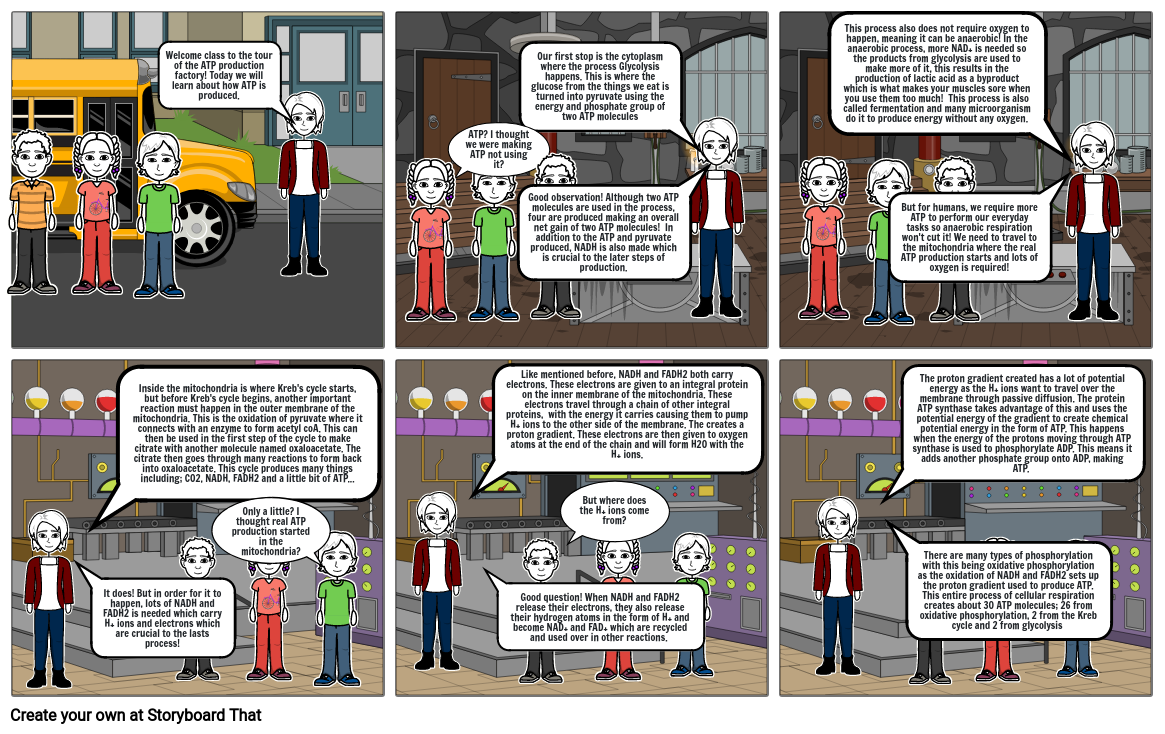U2A8 Cellular Respiration INFOtainment Andrew

Storyboard Text
- Welcome class to the tour of the ATP production factory! Today we will learn about how ATP is produced.
- ATP? I thought we were making ATP not using it?
- Good observation! Although two ATP molecules are used in the process, four are produced making an overall net gain of two ATP molecules! In addition to the ATP and pyruvate produced, NADH is also made which is crucial to the later steps of production.
- Our first stop is the cytoplasm where the process Glycolysis happens. This is where the glucose from the things we eat is turned into pyruvate using the energy and phosphate group of two ATP molecules
- This process also does not require oxygen to happen, meaning it can be anaerobic! In the anaerobic process, more NAD+ is needed so the products from glycolysis are used to make more of it, this results in the production of lactic acid as a byproduct which is what makes your muscles sore when you use them too much! This process is also called fermentation and many microorganism do it to produce energy without any oxygen.
- But for humans, we require more ATP to perform our everyday tasks so anaerobic respiration won't cut it! We need to travel to the mitochondria where the real ATP production starts and lots of oxygen is required!
- It does! But in order for it to happen, lots of NADH and FADH2 is needed which carry H+ ions and electrons which are crucial to the lasts process!
- Inside the mitochondria is where Kreb's cycle starts, but before Kreb's cycle begins, another important reaction must happen in the outer membrane of the mitochondria. This is the oxidation of pyruvate where it connects with an enzyme to form acetyl coA. This can then be used in the first step of the cycle to make citrate with another molecule named oxaloacetate. The citrate then goes through many reactions to form back into oxaloacetate. This cycle produces many things including; CO2, NADH, FADH2 and a little bit of ATP...
- Only a little? I thought real ATP production started in the mitochondria?
- Like mentioned before, NADH and FADH2 both carry electrons. These electrons are given to an integral protein on the inner membrane of the mitochondria. These electrons travel through a chain of other integral proteins, with the energy it carries causing them to pump H+ ions to the other side of the membrane. The creates a proton gradient. These electrons are then given to oxygen atoms at the end of the chain and will form H2O with the H+ ions.
- Good question! When NADH and FADH2 release their electrons, they also release their hydrogen atoms in the form of H+ and become NAD+ and FAD+ which are recycled and used over in other reactions.
- But where does the H+ ions come from?
- The proton gradient created has a lot of potential energy as the H+ ions want to travel over the membrane through passive diffusion. The protein ATP synthase takes advantage of this and uses the potential energy of the gradient to create chemical potential energy in the form of ATP. This happens when the energy of the protons moving through ATP synthase is used to phosphorylate ADP. This means it adds another phosphate group onto ADP, making ATP.
- There are many types of phosphorylation with this being oxidative phosphorylation as the oxidation of NADH and FADH2 sets up the proton gradient used to produce ATP. This entire process of cellular respiration creates about 30 ATP molecules; 26 from oxidative phosphorylation, 2 from the Kreb cycle and 2 from glycolysis
Over 30 Million Storyboards Created

